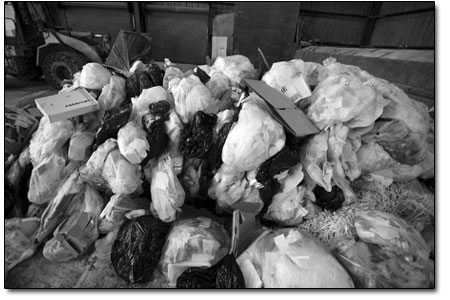|
| ||
| The path to Zero Waste
by Will Sands
The Zero Waste movement is an effort to get individuals and communities to explore all three of the “R’s.” Stepping beyond recycling, Zero Waste emphasizes reducing consumption and reusing products. In addition, the movement advocates a healthy regimen of composting and suggests banning products that are not reusable of recyclable. By cutting the waste stream close to “zero,” the new planning approach conserves resources, minimizes pollution and enhances local economies. The mantra has gone onto the books in municipalities like Boulder, Berkeley and Seattle and has been embraced by corporations ranging from Toyota Motors to MillerCoors. Beyond cutting waste, the communities and companies have reduced their foot prints and realized economic benefits, and the City of Durango could be next. On June 15, Durango councilors instructed staff to begin exploring what it will take to become a Zero Waste community. “Our thinking is that we need to limit the local waste stream,” said Mayor Michael Rendon. “The City was ahead of the curve when we set up the Recycling Center nearly 20 years ago. Unfortunately, we haven’t taken many leaps and bounds since then.” Durango got its introduction to the process in April, when Zero Waste guru Gary Liss visited and addressed officials and members of the public about cutting down on the local waste stream. “Landfills are one of the largest sources of greenhouse gases and a major source of methane,” Liss said this week from his office in Loomis, Calif. “But that’s only the tip of the ‘wasteberg.’ By reducing consumption, you eliminate upstream impacts. You’re no longer producing the products or conducting the mining. These are all big steps we must take before we reach the tipping point for climate change.” During his April visit, Liss took a hard look at the Durango wasteberg and presented the City of Durango with a report card this week. In short, Durango has fallen a little behind the times. “Durango does have a lot of good programs in place,” Liss said. “But you guys need some basic things to go to the next step. One of the biggies is a larger compositing structure.” Organics currently account for approximately half of the local waste stream, according to Liss. He argued in favor of creative solutions to keep these items out of the landfill and make them reusable. He noted that the same can be done for items like old clothes, electronics and building supplies and said Durango’s remote location makes it an optimal candidate for more reuse of materials. “What we’re really talking about is a resource recovery park,” he said. “This would be a place that accommodates recycling, reuse and composting in one easy stop, kind of like a mall does for shopping.” Coincidentally, Durango is taking the formative steps toward creating just such a Zero Waste Facility. The City is putting the finishing touches on an application for a Colorado Department of Local Affairs grant. If awarded, up to $2 million would flow into local coffers to upgrade Durango’s relatively dated Recycling Center (see related story). “I think we’ve recognized in the last couple years that our current recycling facility is outdated,” explained Assistant City Manager Greg Caton. “It’s becoming obvious that it’s run its course. The truth is that it’s a first-generation facility.” According to the best estimates, Durango is still far from Zero Waste. There has not been a Durango waste audit, and Caton’s best guess is that 30 percent of local waste in being recycled or composted and diverted from the landfill. However, Caton and others are confident that Durango can make the count down to zero. Upgrading the Durango Recycling Center into something approximating Liss’ resource recovery park would represent a strong start. “We do have excellent community support,” Caton said. “The fact is that we need a facility that matches our community’s needs, and we just don’t have that now.” For his part, Liss noted that facilities, policies and incentives are all part of the path to Zero Waste. However, he added that in the case of Durango, creativity may be the best tool. “There’s always a way,” he said. “It’s just going to take the willingness of the community and the creativity to develop these initiatives.”
|
In this week's issue...
- May 15, 2025
- End of the trail
Despite tariff pause, Colorado bike company can’t hang on through supply chain chaos
- May 8, 2025
- Shared pain
Dismal trend highlights need to cut usage in Upper Basin, too
- April 24, 2025
- A tale of two bills
Nuclear gets all the hype, but optimizing infrastructure will have bigger impact



 Durango is working to lighten the load on the landfill. City officials are currently exploring what it will take to steer Durango on principles. At the same time, the City is working to bring its Recycling Center and programs into the 21st century.
Durango is working to lighten the load on the landfill. City officials are currently exploring what it will take to steer Durango on principles. At the same time, the City is working to bring its Recycling Center and programs into the 21st century.